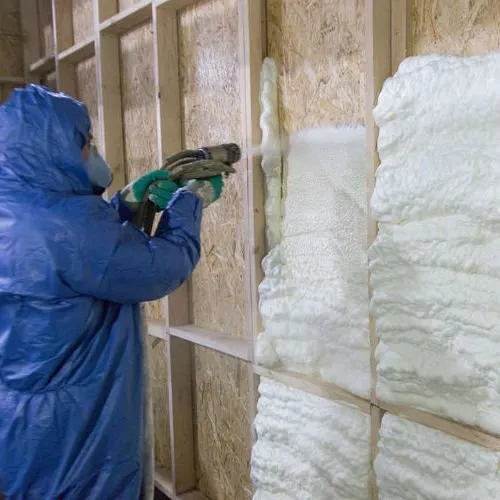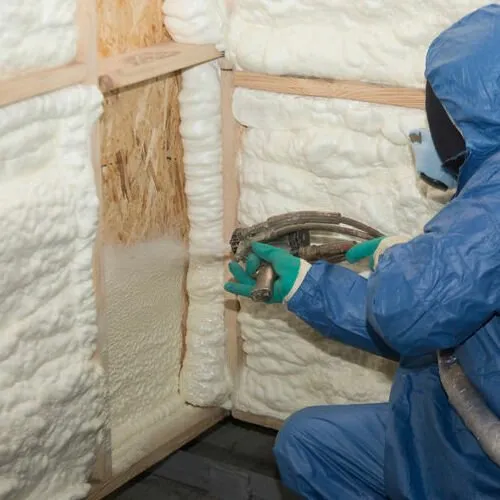Can You Use Spray Foam Insulation in Existing Walls? | Foam Tech
Jun 22, 2020
Can you use spray foam in existing walls?
Whether you have a newly built home or you’re beginning a renovation, you might discover that the insulation in your walls is inadequate. You may even find your home has no insulation at all in your walls. One of the best ways to improve wall insulation is to put in spray foam, and it is not impossible to add spray foam to existing walls without tearing up the walls.

If there is no insulation in your walls, adding spray foam is a fairly easy process, requiring you to basically drill a few easily patched holes in your walls. The foam is simply sprayed into the holes until a section is filled. Then you move on to the next section. This method actually works if insulation is already present, as the foam will just fill in spaces where the other insulation isn’t present. If insulation is present, you’ll want to check to see if it is damp or moldy. Should this be the case, unfortunately you may have to cut out some portions of the wall to remove the old insulation.
When you want to install spray foam wall insulation in Dallas, TX, turn to the professionals at Foam Tech. We are the spray foam experts. You can reach us in Dallas at 214-205-1200 or in Lubbock at 806-441-4636.
How much wall insulation do I need?
When you are trying to calculate how much wall insulation you’ll need, several factors will come into play. First off, you’ll need to know the square footage of the walls in question. Secondly, you’ll have to determine what type of insulation you’re going to use, as well as how much and what type of insulation is present. You will also need to know the R-value of the insulation that’s present, as well as what you’re installing. Ideally, you’ll want R-38 insulation at a depth of about 12 inches. Several calculators are available online that can help you determine how much insulation you’ll need to put in your walls and throughout the rest of your home.
What is the R-value of 2 inches of spray foam?
There are two types of spray foam you can use for wall insulation, open cell or closed cell. Of the two, closed cell tends to have a higher R-value per inch than open cell. Closed cell foam normally has an R-value of between 6.5 to 7 per inch, while open cell has an R-value ranging from 3.5 to 3.6 per inch.
Is spray foam the best insulation?
Spray foam is becoming widely used as insulation. Closed cell spray foam in particular is valued for its high R-values, which fall between 6.5 to 7 per inch. Some of the other reasons why spray foam is being used include:
Advantages of spray foam insulation
- The foam seals up areas other insulation doesn’t cover, preventing air and water seepage.
- Open cell spray foam, in particular, works really well when it comes to noise reduction.
- Helps reduce the amount of pollen and allergens that get into walls.
- Helps prevent insects and small rodents from getting inside the home.
- Can stop mold and mildew growth.
- Sturdiness of the walls is improved.
- It lasts longer than other types of insulation.
- It reduces energy consumption so it is better for the environment.
Can I spray foam myself?
If you want to add spray foam as wall insulation or anywhere else, you can benefit a great deal from it. It’s not, however, recommended to install the foam yourself. In fact, even with kits you might be able to purchase at a big box store, you’ll find instructions saying “For Professional Use Only.” Materials like the paint used to seal the foam can catch fire if there is an open flame nearby. Spraying the chemicals also requires at minimum safety goggles and masks, though many professionals also wear protective suits. Unless you know how to handle the materials and have safety equipment, it’s usually best to get a professional to install the insulation.
Is wall insulation fireproof?
While the individual chemicals used with spray foam can be flammable when being applied, if an open flame is present. The material can be combustible, so a thermal barrier is placed between it and the wall when used as wall insulation. The thermal barrier will prevent the foam from catching fire.
Can wall insulation get wet?
One problem homeowners can face once insulation is installed is the possibility that the insulation can get wet if there is a leak and moisture gets past any vapor or moisture barriers in the walls. Fiberglass insulation is very vulnerable to damage from water and wet insulation needs to be removed as it could lead to mold or mildew growth or even cause structural damage or rotting. Both open- and closed-cell spray foam are highly water resistant. Open cell foam tends to dry very quickly, while closed cell foam will not absorb water.
Do you have to leave your house during spray foam insulation?
Unfortunately, when you have spray foam insulation installed in your home, whether it’s wall insulation or attic insulation, you will have to leave your home for about 24 hours, until the spray foam has dried and hardened. The chemicals in the foam can be toxic when you’re not wearing protective gear like professional installers do.
Is wall insulation worth it?
No matter what kind of wall insulation you install, you’ll benefit from it. Your home’s overall energy efficiency will improve, which will save you in utility costs. This is particularly true with spray foam insulation. If you want spray foam wall insulation in Dallas, TX, the professionals at Foam Tech for expert installation. Schedule a service appointment by calling us either in Dallas at 214-205-1200 or in Lubbock at 806-441-4636.

GET IN TOUCH
We are the undisputed leader for the application of spray foam roofing, insulation, and roof coatings. Foam Tech can provide unparalleled service for your home or business. To learn more about how Foam Tech can benefit your structure, or to schedule a consultation for spray foam roofing in Dallas and Lubbock, TX, give us a call today!